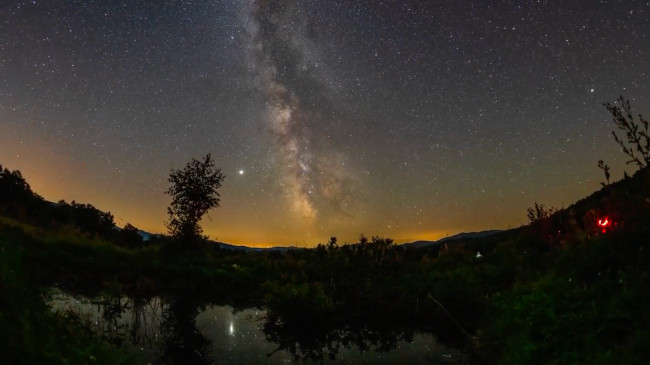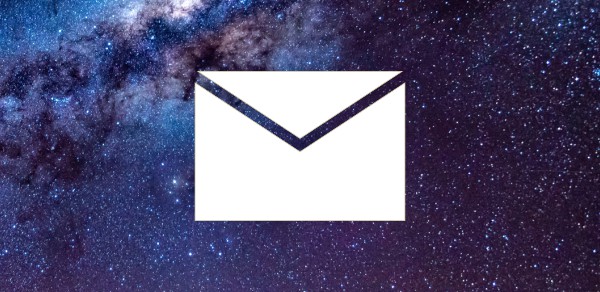This page describes a video Flowing Night Sky
Video caption:
Honourable mention in the 2022 IAU OAE Astrophotography Contest, category Time lapses of celestial patterns.
This time-lapse was shot from Slovakia in August 2020. By fixing the relative movement of the sky to Earth's rotation in some of the frames, we can experience a different perspective as a viewer.
The Milky Way, our home galaxy, is visible throughout the whole video. The bright objects near the Milky Way are Jupiter and Saturn, close together, Jupiter being the brighter one.
This video also shows the interaction of amateur astronomers observing the Perseids meteor shower with their telescopes pointed towards the sky. An unfortunate aspect of the art of astronomical observing, clouds can suddenly cover the whole sky. The fog occurs mostly because of the higher humidity after the rain.
Most of the light trails in the sky are made by satellites, but some of them, appearing just very briefly and not very noticeably, are meteors, as the video was shot around the peak of Perseids meteor shower.
Scroll to captions in other languages
Video credit:
Robert Barsa/IAU OAE
DOI: 10.5281/zenodo.7425689
Related glossary terms:
Jupiter
, Milky Way
, Saturn
, Shooting Star
Categories:
Milky Way and Interstellar Medium
, Naked Eye Astronomy
, Stars
Video license: Creative Commons Attribution 4.0 International (CC BY 4.0) Creative Commons Attribution 4.0 International (CC BY 4.0) icons
The media file captions presented on the OAE website were written, translated and reviewed by a collective effort from the OAE, the OAE Centers and Nodes, the OAE National Astronomy Education Coordinators (NAECs) and other volunteers. You can find a full list of credits for our translation project here. All media file captions are released under a Creative Commons CC BY-4.0 license and should be credited to "IAU OAE". The media files themselves may have different licenses (see above) and should be credited as listed above under "credit".
If you notice a factual error in this caption or an error in any of its translations then please get in touch.
Captions in Different Languages:
Video caption: Lobende Erwähnung beim IAU OAE Astrofoto-Wettbewerb 2022, Kategorie Zeitraffer von Himmelsmustern.
Dieser Zeitraffer wurde im August 2020 in der Slowakei aufgenommen. Teilweise wird in den einzelnen Sequenzen die relative Bewegung des Himmels zur Erdrotation festgehalten, so dass wir als Betrachter*innen eine andere Perspektive erleben.
Unsere Heimatgalaxie, die Milchstraße, ist während des gesamten Videos zu sehen. Die hellen Objekte in der Nähe der Milchstraße sind Jupiter und Saturn, die dicht beieinanderstehen, wobei Jupiter der hellere ist.
Das Video zeigt auch das Treiben von Amateurastronom*innen, die mit ihren Teleskopen beobachten und den Nachthimmel fotografieren. Ein Aspekt der astronomischen Beobachtungskunst ist, dass Wolken plötzlich den ganzen Himmel bedecken können. Der Nebel entsteht meist durch die höhere Luftfeuchtigkeit nach dem Regen.
Die meisten der Lichtspuren am Himmel stammen von Satelliten, aber einige von ihnen, die nur sehr kurz und unauffällig erscheinen, sind Sternschnuppen, denn das Video wurde um den Höhepunkt des Perseiden-Meteorstroms herum aufgenommen.
Video credit: Robert Barsa/IAU OAE
Related glossary terms: Jupiter , Milchstraße , Saturn , Sternschnuppe Caption translation status: Not yet approved by a reviewer
Caption translators: Carolin Liefke
Video caption: Menzione d'onore al concorso di astrofotografia IAU OAE 2022, categoria Time lapses of celestial patterns.
Questo time-lapse è stato ripreso dalla Slovacchia nell'agosto 2020. Fissando il movimento relativo del cielo alla rotazione della Terra in alcuni fotogrammi, possiamo sperimentare una prospettiva diversa come spettatori.
La Via Lattea, la nostra galassia natale, è visibile in tutto il video. Gli oggetti luminosi vicino alla Via Lattea sono Giove e Saturno, vicini tra loro; Giove è il più luminoso dei due.
Questo video mostra anche l'interazione di astronomi dilettanti che osservano lo sciame meteorico delle Perseidi con i loro telescopi puntati verso il cielo. Un aspetto spiacevole dell'arte dell'osservazione astronomica è che le nuvole possono improvvisamente coprire l'intero cielo. La nebbia si verifica soprattutto a causa della maggiore umidità dopo la pioggia.
La maggior parte delle scie luminose nel cielo sono prodotte dai satelliti, ma alcune di esse, che appaiono solo molto brevemente e in modo poco evidente, sono meteore, dato che il video è stato girato intorno al picco della pioggia di meteore Perseidi.
Video credit: Robert Barsa/IAU OAE
Related glossary terms: Giove , Saturno , Stella cadente , Via Lattea Caption translation status: Approved by a reviewer
Caption translators: Valentina La Parola
Caption reviewers: Rodolfo Canestrari
Video caption: 2022 年国际天文学联合会 OAE 天体摄影竞赛 "延时天体图案 "类别荣誉奖。
这幅延时摄影作品是 2020 年 8 月在斯洛伐克拍摄的。通过在部分画面中固定天空与地球自转的相对运动,作为观众的我们可以体验到不同的视角。
银河系,我们的家园星系,在整段视频中清晰可见。银河附近明亮的天体是木星和土星,它们靠得很近,其中木星更亮。
这段视频还展示了业余天文学家用望远镜对准天空观测英仙座流星雨的互动过程。天文观测的一个遗憾是,有时云层会突然遮住整个天空。云雾出现的主要原因是雨后湿度较大。
天空中的大部分亮线都是由卫星造成的,但其中有些出现的时间很短,也不是很明显,它们是流星,因为这段视频是在英仙座流星雨高峰期前后拍摄的。
Video credit: Robert Barsa/IAU OAE
Related glossary terms: 土星 , 木星 , 流星 , 银河系 Caption translation status: Not yet approved by a reviewer
Caption translators: Hu Xueying
Video caption: 2022 年國際天文學聯合會 OAE 天體攝影競賽 "延時天體圖案 "類別榮譽獎。
這幅延時攝影作品是 2020 年 8 月在斯洛伐克拍攝的。通過在部分畫面中固定天空與地球自轉的相對運動,作為觀眾的我們可以體驗到不同的視角。
銀河系,我們的家園星系,在整段視頻中清晰可見。銀河附近明亮的天體是木星和土星,它們靠得很近,其中木星更亮。
這段視頻還展示了業餘天文學家用望遠鏡對準天空觀測英仙座流星雨的互動過程。天文觀測的一個遺憾是,有時雲層會突然遮住整個天空。雲霧出現的主要原因是雨後溼度較大。
天空中的大部分亮線都是由衛星造成的,但其中有些出現的時間很短,也不是很明顯,它們是流星,因為這段視頻是在英仙座流星雨高峰期前後拍攝的。
Video credit: Robert Barsa/IAU OAE
Related glossary terms: 土星 , 木星 , 流星 , 銀河系 Caption translation status: Not yet approved by a reviewer
Caption translators: An automated transliteration from the simplified Chinese translation by - Hu Xueying









